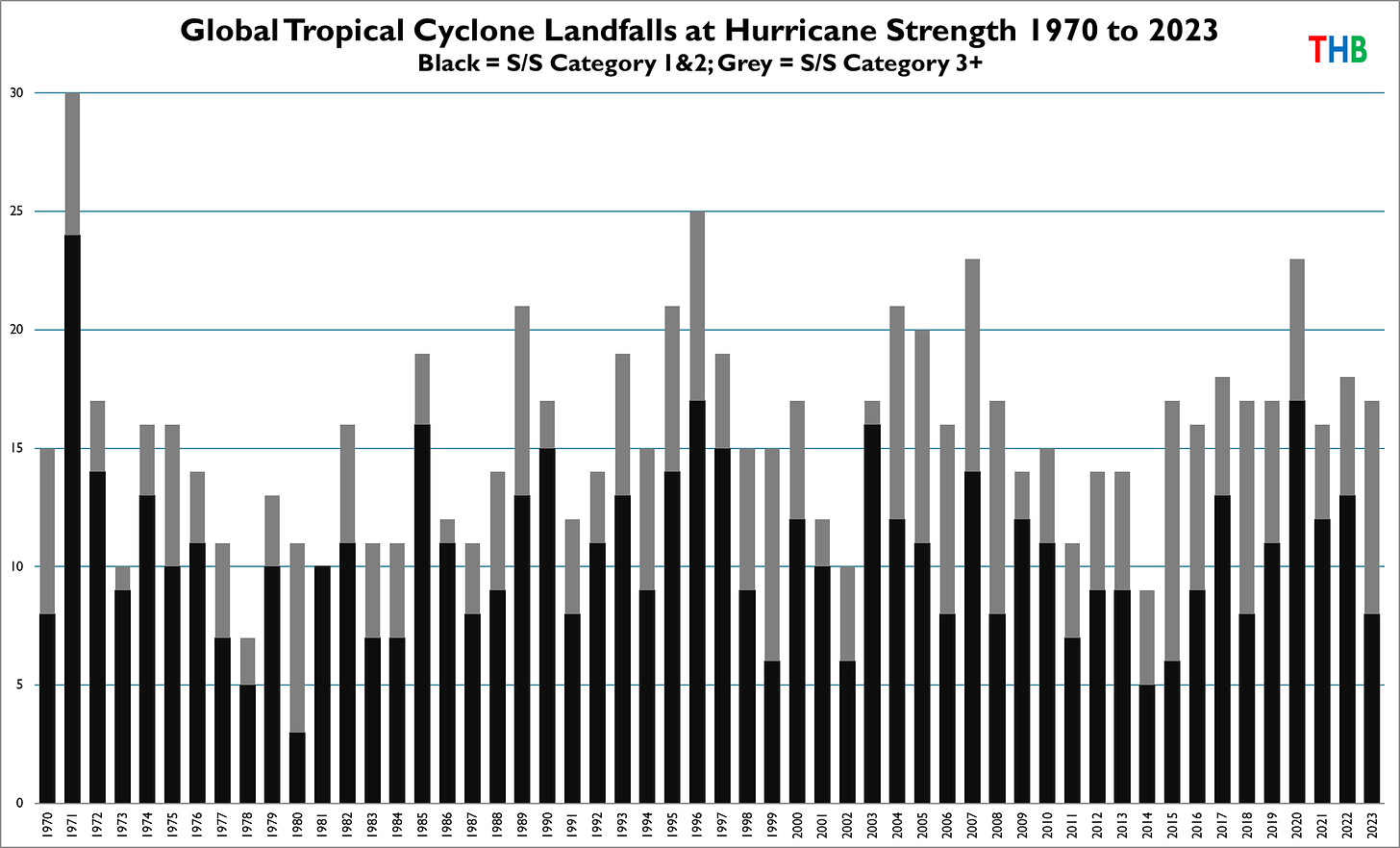This post is co-authored with Ryan Maue, whose Weather and Climate Substack I highly recommend. —RP
In 2012, Jessica Weinkle, Ryan Maue and I published in the Journal of Climate the first climatology of global landfalling tropical cyclones of at least hurricane strength. Since then, Ryan and I have updated the time series every year.
Landfalling hurricanes (also called typhoons or cyclones) are an important subset of tropical cyclones because these storms cause the most damage of any type of extreme event, with most of these losses occurring in the United States.

The figure below shows total global landfalling hurricanes and major hurricanes, 1970 to 2023. The graph starts in 1970 because that is when reliable information is available globally, however several basins have records that go back further in time.

The figure below shows the same data with linear trends for minor (Saffir/Simpson Categories 1 and 2) and major (S/S 3+) hurricanes.

You can see that since 1970 there is no trend in landfalls of minor hurricanes and an upward trend in major hurricanes. Might this be the consequence of human-caused climate changes?
We can get a sense of the meaningfulness of a trend that starts in 1970 by looking further back in time for the Western North Pacific and North Atlantic which together saw 67% of all global hurricane landfalls from 1970 to 2023. The combined landfalls of minor and major hurricanes for these two basins is shown below and there is no trend in either category.

Below is the same data, but starting from 1970, and you can clearly see that major hurricane landfalls increase over this shorter period, in contrast to beginning the analysis in 1950, when data for these two basins is first available.

In technical terms, detection of change has not been achieved — which is fully consistent with the scientific consensus of NOAA and the IPCC. Without detection there can be no attribution under the IPCC framework for detection and attribution. Given the large interannual and decadal variability in tropical cyclones, data are easily cherrypicked (intentionally or unintentionally) to identify spurious trends.
The figures below show the distribution of global landfalling storm counts for major and total hurricanes for the period 1970 to 2023, showing large variability.

Landfalling hurricanes are of course just a subset of tropical cyclones, as many storms stay out to sea. Ryan has just updated his excellent figures on global tropical cyclone activity. The figure below shows running 12-month sums of all hurricanes and major hurricanes since 1980.
The figure below extends back to 1970 and includes tropical storms, which are tropical cyclones that are less than hurricane strength, but Ryan warns of the pre-1980 data that, “Data prior to mid-1980s is spotty in parts of the Southern Hemisphere and Eastern Pacific with the lack of satellite imagery. The 1970s intensity data has large uncertainty [+missing] outside of the Western Pacific and North Atlantic.”
While doing his update Ryan discovered a remarkable fact: During 2023 the running three-year sum of major hurricanes was at its lowest since 1980. Interesting!
Finally, from the excellent data maintained by Phil Klotzbach at Colorado State University, we can look at yet another set of metrics — Accumulated Cyclone Energy (ACE, which combines frequency and intensity) and ACE per hurricane. These figures are shown below, and you can clearly see no trends in these metrics since 1980. Over this time period and according to these metrics, hurricanes have not become more intense.


Comments, questions, debate and discussion are all invited. Please share these figures as people almost certainly won’t find them anywhere else!
Thanks for reading! THB is supported by you.








Are there figures specifically on rainfall amounts associated with landfalling cyclones? Could the IPCC claim that rainfall totals (one of the most damaging aspects of cyclone activity) are increasing even if the number of events is not? Does the rainfall amount correlate with accumulated cyclone energy ... in which case we wouldn't expect a trend since there is none in ACE ?
Hi Roger, thanks for sharing this analysis. I've seen some conflicting reports on this topic. For example:
Steve Koonin's book quotes CSSR's Section 9.2: "... there is still low confidence that increases in TC [Tropital Cyclone] activity are robust, after accounting for past changes in observing capabilities [...] The trend signal has not yet had the time to rise above the background variability of natural processes"
However, I looked up the latest AR6 'Longer Report' (https://report.ipcc.ch/ar6syr/pdf/IPCC_AR6_SYR_LongerReport.pdf) and I find this:
"Human-caused climate change is already affecting many weather and climate extremes in every region across the globe. Evidence of observed changes in extremes such as heatwaves, heavy precipitation, droughts, and tropical cyclones, and, in particular, their attribution to human influence, has strengthened since AR5"
(and further down) "Event attribution studies and physical understanding indicate that human-caused climate change increases heavy precipitation associated with tropical cyclones (high confidence)."
'high confidence' has a very specific meaning in the AR6 report. How does one reconcile that with the data you've shared?